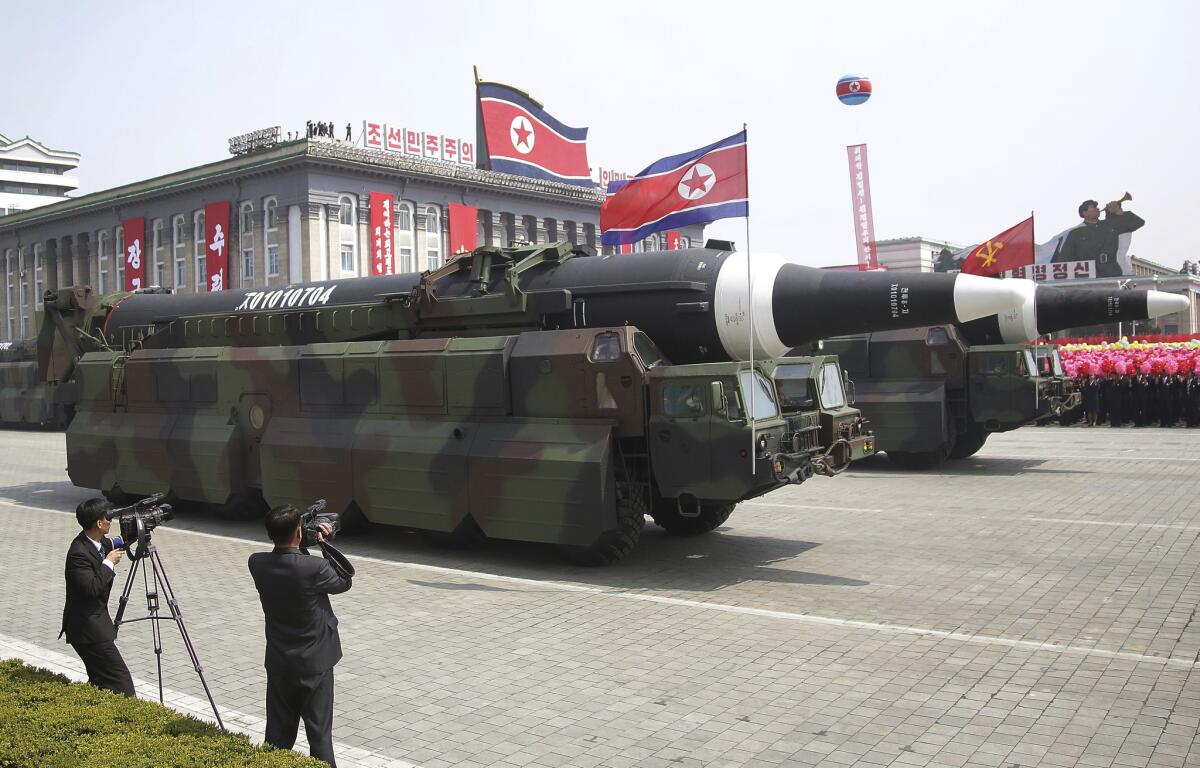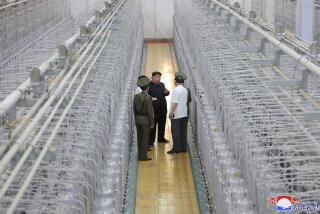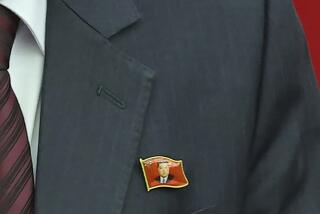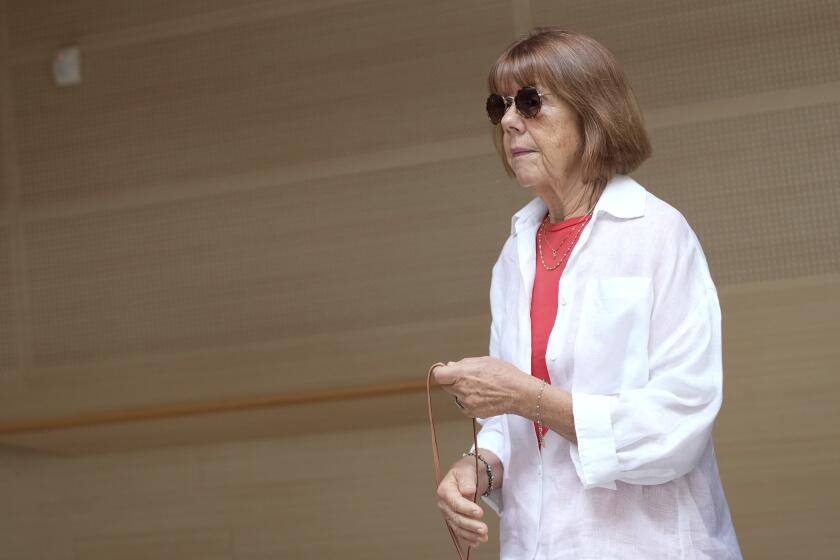North Korea puts its long-range missiles on parade in massive military show

It was a day of spectacle: Jets soared overhead, flying in formation to form the number “105,” the number of years since the birth of Kim Il Sung, who forged an isolated “workers state” on the northern Korean Peninsula.
Tens, perhaps hundreds, of thousands of citizens — the men dressed in suits, the women in traditional Korean dresses — marched through central Pyongyang, clutching pink artificial flowers and national flags.
They clustered around floats adorned with political slogans. “Long live the socialist medical system,” said one, which was surrounded by doctors. Another, depicting a new residential development in Pyongyang, read: “We are the happiest in the world.”
The marchers turned their heads upward to North Korea’s current leader, Kim Jong Un, who surveyed the massive show of military might and public adulation from a high rostrum. Some wept.
The colorful show of pageantry and power Saturday offered a rare glimpse of one of the world’s most secretive societies. It also provided an opportunity for North Korea — striving to become the world’s next nuclear power — to stage a provocative display of the military hardware it continues to develop in defiance of international sanctions.
The government did not test a nuclear weapon to mark the anniversary, as many analysts had expected. A missile launch was attempted early Sunday, according to U.S. and South Korean officials, but it fizzled.
In a speech, Choe Ryong Hae, the vice chairman of North Korea’s ruling Workers’ Party of Korea — widely believed to be the country’s second-most powerful man — warned that Pyongyang would not hesitate to deploy nuclear weapons against the U.S.
“Now the U.S. imperialists have struck a sovereign country,” he said, referring to President Trump’s recent airstrike on a Syrian airbase in retaliation for a chemical weapons attack. “Now, they are dispatching nuclear forces in the territory of the Korean peninsula. If the U.S. government preemptively strikes our country, we are ready to counter strongly.”
Trump diverted a naval strike group toward the peninsula last week, led by the USS Carl Vinson, a large aircraft supercarrier accompanied by destroyers and a guided-missile cruiser. It is not known to carry nuclear weapons.
The North Korea-U.S. showdown has placed northeast Asia in a state of heightened anxiety. Vice President Mike Pence arrives in Seoul this weekend to discuss North Korea’s nuclear ambitions and affirm support for U.S. allies. Japanese Prime Minister Shinzo Abe claimed Friday that North Korea may be able to arm its missiles with sarin nerve agent, and the country’s national security council reportedly has discussed how to evacuate its nearly 60,000 citizens from South Korea in the event of a North Korean attack.
Chinese Foreign Minister Wang Yi warned that a military conflict between North Korea and the U.S. could break out “at any moment” and urged the two powers to avoid the “irreversible route” of war.
The parade featured a seemingly endless procession of tanks, missile-bearing trucks and soldiers who goose-stepped in such perfect unison that the ground shook.
North Korea presented several new pieces of military hardware, South Korea’s Yonhap news agency reported, including a type of inter-continental ballistic missile, or ICBM.
North Korea is trying to develop a nuclear-tipped ICBM that could reach the continental United States; some analysts believe it could acquire that capability within a decade.
Other new weapons on display included Pukkuksong submarine-launched ballistic missiles, which North Korea tested last year and are harder to detect than land-launched ICBMs.
Yet the show of force left unanswered questions about the equipment’s reliability. The parade didn’t go off seamlessly; a North Korean live broadcast of the event showed one tank begin to billow smoke, then turn away before the column continued through Kim Il Sung Square.
Daniel Pinkston, a North Korea expert and international relations expert at Troy University in Seoul, said the North Korean government probably wanted to signal its move toward developing solid-fuel missiles, which can be deployed much more quickly than liquid-fuel missiles in the event of a military conflict.
“I think it’s becoming clearer that North Korea has what we call an ‘asymmetric escalation nuclear posture,’” Pinkston said. It’s suggesting that “if we’re getting overrun [in conventional combat], we reserve the right to use nuclear weapons first. That’s what North Korea is doing, and that’s really dangerous.”
Trump has pressured China to rein in North Korea’s nuclear program, threatening on Twitter that if it doesn’t, the U.S. could act on its own. China has taken steps to defuse the situation. On Friday, Wang, the foreign minister, pledged to try to renew talks with North Korea in a phone call with his Russian counterpart, Sergei Lavrov, according to China’s foreign ministry.
China also has temporarily halted its coal imports from North Korea — a measure that Trump praised this week in a news conference. But it’s unclear how much farther China — the reclusive nation’s biggest benefactor — is willing to go. Beijing fears that a regime collapse in Pyongyang would send refugees across the two countries’ shared border and destroy the buffer between itself and South Korea, a staunch U.S. ally.
Trade between China and North Korea has actually increased in the first quarter of 2017, rising 37.4% from the same period last year, according to Chinese government figures. China buys garments and minerals such as iron ore from North Korea, while North Korea relies on the larger communist country for just about everything else — including most of its food and energy supplies.
John Delury, a professor at Yonsei University in Seoul, said that the recent round of tensions calls to mind episodes in 2010, when North and South Korea exchanged artillery fire, and in 2015, when Kim ordered front-line troops onto war footing.
“That was driven by South-North stuff, and the U.S. was there, kind of posturing,” he said. “This time, Trump is egging it on. But Kim Jong Un has showed that he’s ready to be this ‘go to the edge of the cliff and not blink’ kind of leader. He’s doing that again now.”
Experts say that the U.S. has no good options on the peninsula. A preemptive strike could provoke North Korea to attack Seoul, one of Asia’s most developed and cosmopolitan cities, potentially killing hundreds of thousands of people.
“There are just a lot of constraints on attacking North Korea,” said Robert Kelly, a professor of political science at Pusan National University in Seoul. “South Korea isn’t configured very well to absorb North Korean counterfire: 55% of its population lives within 75 miles of North Korea. It’s insane. It’s like facing a fencing partner without any armor over your chest.”
Throughout the parade, which lasted for about two hours, Kim stood above the crowd, wearing a black suit and white tie. He clapped, waved and saluted for more than two hours, as hundreds of thousands of North Koreans streamed by, howling, “Long live,” their faces contorted with emotion.
Afterward, as municipal workers swept artificial flower petals from the square, Youn Dok-kin, a 47-year-old doctor, said that North Korea’s nuclear weapons program made him proud.
“Our country has always been threatened by the nuclear weapons of the U.S. imperialists,” he said. “Now, we have our own nuclear force, and our country can defend our national security, and our peace.”
For more news from Asia, follow @JRKaiman on Twitter
Special correspondent Jessica Meyers in Beijing contributed to this report.
ALSO
We’re in North Korea. Want to know what it’s like here? Send us your questions
North Korea says it’s ready for war, but Pyongyang remains a city of orderly calm
UPDATES:
4:50 p.m.: This article was updated with news of an attempted missile launch by North Korea.
This article was originally published at 8:50 a.m.
More to Read
Sign up for Essential California
The most important California stories and recommendations in your inbox every morning.
You may occasionally receive promotional content from the Los Angeles Times.










